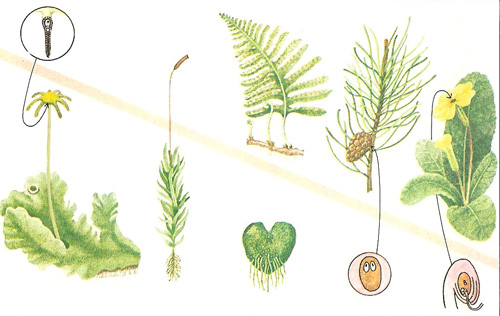alternation of generations

Many plants have two distinct phases in their life cycles. The gametophyte which produces the haploid male and female gametes; and the sporophyte which produces diploid spores. During the course of evolution there has been a gradual shift from the gametophyte being the dominant form, i.e., the planet we recognize, to the sporophyte being the dominant form. This illustration shows the gametophytes of various plant types below the diagonal line and the sporophytes above the line. From left to right the examples are: a liverwort in which the green thallus is the gametophyte, while the sporophyte is represented by the fertilized egg and the capsule that develops from it; a moss in which the upright leafy plant is the gametophyte and the capsule the sporophyte that lives upon it; in the ferns the dominant plant is the sporophyte , while the gametophyte is a small, free-living flattened prothallus that produces the gametes; in conifers and flowering plants the sporophyte is the only conspicuous phase, the male gametophyte being contained in the pollen grains and the female gametophyte represented by the egg and surrounding tissues.
Alternation of generations is a feature of the life cycle of most plants and many lower animals by which successive
generations reproduce alternately sexually and asexually.
In animals the feature is exhibited by flukes, tapeworms, and other cnidaria,
including the common jellyfish (Aurelia
aurita) and the sea fir Obelia.
In plants the sexually reproducing or gametophyte generation gives rise to haploid male and female sex cells (gametes) which, on fertilization, become a diploid zygote which in turn germinates into the asexually reproducing sporophyte generation. This reproduces by forming spores which germinate to give the gametophyte generation again. In lower plants such as the liverworts and mosses, the gametophyte generation is dominant but in flowering plants the gametophytes are reduced to microscopic proportions, the plant itself being the sporophyte generation.


